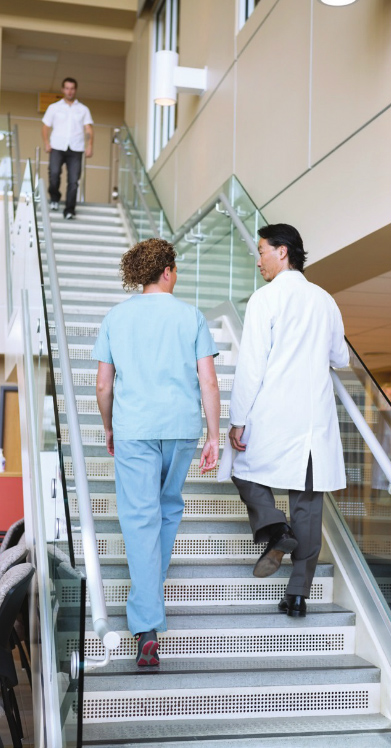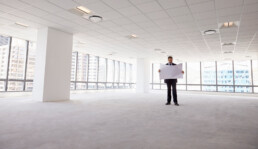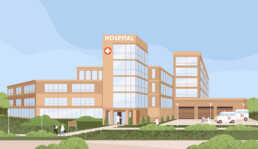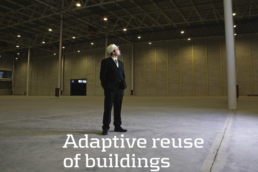The word “retrofit” as we are aware suggests fitting in or on to an existing structure OR to substitute new or modernized parts or equipment for older ones. This has been in vogue for the last few years with an objective of protecting existing as well as utilizing redundant facilities. This applies to Healthcare facilities as well since they are always constantly evolving in terms of technology, methodology and care delivery systems. Retrofitting is an apt way to keep step with the transformation.
Across the country Day-Care Surgery Centers, Specialty Hospitals, Diagnostic Centers are coming up close to where patients live, work and shop. And there’s plenty of real estate to choose from to set-up these ventures, in the absence of adequate land space availability. A once inhabited but now-defunct retail space or a commercial premise, there are plenty of existing structures available that have convenient access to highways, plenty of parking, and all the amenities that a healthcare facility would desire. But converting former retail / commercial locations into contemporary healthcare clinics doesn’t come without challenges.
While it might seem more logical to bring down some of the dilapidated Hospital buildings, many yearn to be given a second chance at life. Many a times these are Heritage Structures which need to be retained as per the rules. With congested urban infrastructure and limited construction budgets in light of the economy, many healthcare facilities are considering refurbishment and retrofitting as a viable alternative to a new-build project. Retrofitting in an existing healthcare set-up has its own set of challenges, not only in remaining fully functional at all times to treat patients, but also keeping tight control of infection.
There has been a flow of funding for capital projects within the Indian healthcare sector, and new projects are coming up at a fast pace. With the land availability decreasing in the cities, stakeholders are looking towards non-operational retail or commercial premises to start their ventures. Many existing health facilities are driving retrofitting projects to accommodate new clinical technology, changes in regulations or to upgrade to NABH / JCI standards and also improving energy efficiency to make the facilities GREEN. Healthcare retrofits provide numerous benefits ranging from improved equipment longevity to decreased patient recovery times to a more attractive brand. Be it the retrofitting of an already existing facility to adapt to the current practices or converting a defunct structure into a healthcare facility both is extremely interesting but challenging.
FACTORS TO BE CONSIDERED WHILE RETROFITTING FOR HEALTHCARE FACILITIES
1. Structural Stability of the Structure
The structural stability of the structure needs to be determined prior to embarking on the planning propositions in order to assess the strength for aged structures and to assess changeability for retail / commercial spaces to adapt to healthcare requirements. Many a times the criteria for locating say a radiology or radiotherapy department might be dictated by the ability of a particular space to take the loading of the heavy equipment rather than the proximity to the emergency or outpatient department. Similar assessments would need to be done say while locating the toilets within a healthcare facility being retrofitted in a mall, as the pre-stressed slabs and beams offer limitations in core-cutting to provide accessibility to drainage lines. In heritage structures, an methodology of construction like jack-arches for slabs or load bearing walls might pose hindrances during the process of transformation as these may be needed to be handled with care giving due time for the structures to settle and adapt to the change before proceeding with further improvements.
2. Adaptability of the Structure to the current Land Rules, Operational practices and Technology
While re-developing an existing building (either a mall or a commercial premise or even re-vamping of an existing facility) to retrofit for a modern day healthcare facility a few checks are essential on the succeeding points

a. Land rules – Staircase Width: A retail or commercial space design allows for a 1.5m wide access staircase, while a healthcare facility necessarily requires a 2.0m wide access staircase as per NBC (National Building Code). Even older healthcare facilities were designed with 1.5m wide staircases which need to be modified / altered or an additional 2.0m staircase needs to be provided.
b. Land Rules – Fire Rules: The FIRE REGULATIONS of NBC have made it mandatory to have a minimum of enclosed two staircases, with minimum travel distance being 15m and maximum of 22.5m between the routes of escape. Thus at times it becomes essential to introduce staircase to comply with the rules, which of-course are in the best interest of the public, but incurs an additional cost.
c. Technology – Lifts: retail or commercial premise has passenger elevators, while a hospital needs bed lifts to transfer patients between floors. The older facilities would typically have stretcher lifts, which are smaller in width and do not accommodate the patient beds. While making operational changes hospitals today are adapting to the latest healthcare furniture which adapts to the most patient requirement without displacing the patient from his / her bed. Thus the discomfort of shifting after surgeries etc. is avoided.
d. Technology – equipment: incorporating heavy and large equipment like the CT scan or MRI scan in existing buildings does comes along with its challenges. Malls and commercial buildings have glazed facades which need to dismantled and re-done to gain entry inside, while older facilities have reduced strengths of structural members or insufficient space to accommodate the same.
e. Operational practices: Many existing facilities are keen to adhere to the best practices of the industry and are striving to get accreditations for their services. NABH and JCI are the primary ones that are predominant for medium to large set-ups while the recently introduced AHPI standards are applicable for smaller set-ups. These do mention of certain minimum infrastructure requirements; in case of existing building these might pose challenges for adaptability.
3. Energy Efficiency of the Structure
Among the factors that benefit a healthcare facility while retrofitting, energy efficiency upgrades are likely to offer the highest returns with the lowest risks. Designing the retrofitting to make use of the natural day-light and natural ventilation not only reflect direct cost reductions provided through reduced energy use but are accompanied by valuable non-energy benefits as well. The primary drivers for most healthcare facility owners to capitalize on energy efficiency are to realize the direct benefits of reduced utility costs, while providing a healthier and more comfortable environment for patients. The non-energy benefits are hard to quantify but should be considered as they support the overall healthcare facility.
Three important parameters that are to be considered are lower operating costs, improved patient care, and an enhanced public image.
- Lower Operating Costs: High operating costs are the primary reason for implementing energy improvements. Utility bills constitute a large percentage (–) of hospital operating revenues on average and every rupee saved improves the operating margins. Large Hospitals can retrofit the electrical, ventilation systems and upgrade from CFL (compact fluorescents lights) to LED (Light Emitting Diodes) and Air cooled system to Variable flow system to get the benefits of newer technologies and functional diversity. Added advantages of technology would be to use the air-conditioning heat transfer process to heat water in boilers as also to use STP to recycle waste water and re-use for landscaping which in-turn would keep the surrounding around the hospitals fresh and cool.
- Improved Patient Care: Energy efficiency improvements benefit to improve the indoor environment. It is known that more comfortable, pleasing surroundings help make hospitals safer and improve patient outcomes. Upgrading HVAC systems with proper air-changes improves the Indoor Air Quality and reduces the occurrence of hospital-acquired airborne infections. The HVAC system in healthcare retrofit need an extra bit of care, more than design efficiency it’s the inspection before the work begins that need attention. All the loose end should be sealed to ensure zero leakage. Through the years we have realized that every cubic feet per minute of cooled air lost costs an average of 11 Watts of additional power. As fresh air is a need in this sector energy recovery should be used, with abundance usage these systems have a quick payback of at most 5 years. Adequate Lighting can help eliminate patient falls, and daylighting improves frame of mind, reduces anxiety and depression. Improvements to malfunctioning equipment can increase acoustic comfort and reduce noise.
- Enhanced Public Image: In today’s times watching over one’s carbon footprint is of utmost importance and the in-thing. Many organizations like the U.S. Green Building Council’s (USGBC) Leadership in Energy and Environmental Design (LEED) program and, India’s Association for Development and Research of Sustainable Habitat’s (ADaRSH) Green Rating for Integrated Habitat Assessment (GRIHA) have helped institutions to take steps to improve energy efficiency and gain acknowledgement for their accomplishments.
4. Face-Lift to the façade and interiors to improve patient comfort, safety and accessibility
With the opening-up / globalization of the economy and the increased awareness about insurance, the paying capacity of patients for the healthcare services they receive has increased. The “patient” as a “consumer” of the healthcare industry demands comfort and safety. Infrastructure retrofits need to incorporate
- Adequately spacious in-patient rooms, consultation rooms etc. with privacy for the patient, natural day-light, thermal comfort
- Safety in terms of security and fire mandatorily needs to be provided, both from patient and well as facility point-of view
- Accessibility refers to creating an environment in which the patient can operate on his own accord – providing adequate ramps and lifts, providing accessible toilets, installing dual language signage
5. The Project Budget
Last but not the least we have to do a reality check. While constructing a new Hospital Facility is most ideal, it requires significant capital expense compared to which the cost of a retrofit would be incremental and lesser. The project teams must be able to map the desired out-put with the budget and accordingly recommend solutions. This can be done by avoiding the temptation to specify changes, products and technology that are not critical to the concerned healthcare facility since it doesn’t benefit the client, whose main concern is to have the right upgrade with an optimum cost. It is critical that the project team applies the design principles understanding the client business model and the characteristics and limitations of the facility they are trying to develop. It is important for a client to select a project team with technical capability to develop a healthcare facility and also the ability to demonstrate the financial awareness. Hence making sure the owner’s capital and performance expectations are always aligned.
The coming era will see an enhanced importance to the philosophy of “retrofitting “ which certainly has the potential of giving a facility best of Design and Efficiency.
Article printed in Healthcare Radius – April 2014
References:
- Article in Healthcare Design by Jennifer Kovacs Silvis, August 2013
- Retrofitting to Reduce Carbon Footprint by David C. Fishel, PE, LEED AP BD+C
- Article by Freistat, business development executive for LED Source, an LED lighting solutions provider based in Wellington, FL.
- Advanced Energy Retrofit Guide Practical Ways to Improve Energy Performance Healthcare Facilities, Prepared by: National Renewable Energy Laboratory
- Inputs from Navneet Mitra, Principal Consultant, IBSC consultants.
Related Posts
Successful Brownfield Healthcare Projects
Facility upgrades in hospital design and construction are inevitable, whether it is to accommodate…
Healthcare Design for Greenfield Projects
Setting up a new healthcare centre, hospital, and clinic can be extremely rewarding - personally…
Repurpose and Resuscitate!
Over the last few years, healthcare organisations have demonstrated a tendency to protect and…
Adaptive Reuse of Buildings
Malls are going through a downturn as there is a decrease in the number of people spending hours in…




